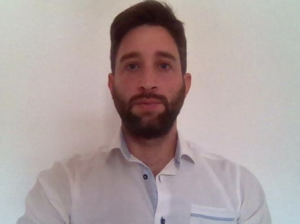 ECTRIMS Congresses represent a great outlet for emerging investigators to feel part of a bigger community. Young researchers can benefit from the opportunity to share their studies and discuss with colleagues working on the same topic. Researchers at various stages of their career expand their network, learn about each other’s work, establish new collaborative efforts, enrich their perspective on the latest advancements and shape future directions. Participating in the ECTRIMS Congress can also offer young investigators chances to practice their presentation skills and increase their visibility.
ECTRIMS Congresses represent a great outlet for emerging investigators to feel part of a bigger community. Young researchers can benefit from the opportunity to share their studies and discuss with colleagues working on the same topic. Researchers at various stages of their career expand their network, learn about each other’s work, establish new collaborative efforts, enrich their perspective on the latest advancements and shape future directions. Participating in the ECTRIMS Congress can also offer young investigators chances to practice their presentation skills and increase their visibility.
Last year, at MSMilan2023 two young investigators won the “Best Young Investigator Award” for the best oral presentations.
Best Young Investigator Award Winners
Matteo Betti and Vyanka Redenbaugh obtained the “Best Young Investigator Award” at MSMilan2023. The studies they presented addressed questions that are currently at the core of scientific research on multiple sclerosis (MS).
 Matteo Betti – University of Florence – discussed a retrospective study on a real-world cohort that aimed at evaluating possible modifications of the efficacy of disease-modifying treatments (DMTs) related to age. The study included data of 22,196 people with MS acquired from the Italian Multiple Sclerosis Register. The Italian Multiple Sclerosis Register represents a multicentric project – sustained by AISM (Italian Association of MS) – that collects the data of the patients living with MS who visit MS centers in Italy [1].
Matteo Betti – University of Florence – discussed a retrospective study on a real-world cohort that aimed at evaluating possible modifications of the efficacy of disease-modifying treatments (DMTs) related to age. The study included data of 22,196 people with MS acquired from the Italian Multiple Sclerosis Register. The Italian Multiple Sclerosis Register represents a multicentric project – sustained by AISM (Italian Association of MS) – that collects the data of the patients living with MS who visit MS centers in Italy [1].
Currently, a wide range of highly effective DMTs is available to treat multiple sclerosis. However, a meta-analysis of 38 clinical trials, involving more than 28,000 individuals with MS, suggested that the efficacy of immunomodulatory DMTs decreases with age [2]. After the age of 40, the efficacies of all DMTs in slowing down MS disability overlap and no therapeutic benefit was predicted after the age of 53 [2]. This represents an important challenge, especially considering that while the peak age prevalence in Europe and Northern America is rising – from 40 to 60 years of age – clinical trials have mostly included patients up to 55 years old [3]. Therefore, retrospective studies that investigate the age-dependent efficacy of DMTs in real-life cohorts can be especially valuable in supporting clinical decision-making. Matteo Betti and colleagues analysed a real-world population of people with Clinically Isolated Syndrome (CIS) and relapsing-remitting MS. Key results indicated that older age at DMT start was related to reduced efficacy of DMT – in terms of prevention of disability accrual. Nonetheless, independently of age, starting early high-efficacy DMTs decreased the risk of disability worsening.
 Vyanka Redenbaugh – MD at the Mayo Clinic College of Medicine in US – and colleagues investigated the role of myelin oligodendrocyte glycoprotein IgG (MOG-IgG) in cerebrospinal fluid (CSF) and intrathecal synthesis in the diagnosis of myelin oligodendrocyte glycoprotein antibody-associated disease (MOGAD). MOGAD is an inflammatory disease of the central nervous system that can share some symptoms with other neuroinflammatory disorders, including MS [4]. The 2023 MOGAD diagnostic criteria consider the presence of serum MOG-IgG – detected with cell-based assays – a fundamental diagnostic criterion for MOGAD [5]. In specific circumstances, a CSF testing for MOG-IgG is recommended to support a MOGAD diagnosis. For instance, when clinical and MRI features support a diagnosis of MOGAD, but the patients are MOG-IgG seronegative [5]. Most of the studies have measured MOG-IgG in serum, and only recently MOG-IgG has been measured also in CSF [6]. Therefore, the interest to further assess the diagnostic utility of CSF MOG-IgG on large control populations is growing. The research presented by Vyanka Redenbaugh assessed the correlation between serum and CSF MOG-IgG and intrathecal synthesis. 447 CSF samples were evaluated across four patients’ groups: inflammatory (including 82 MS) and non-inflammatory controls; MOGAD patients with serum MOG-IgG positive; false positive serum MOG-IgG and high-risk phenotypes negative for serum MOG-IgG. The results showed that CSF MOG-IgG is sensitive (90%) and highly specific (98%) for MOGAD. Isolated positivity of CSF MOG-IgG occurred in 11% of MOGAD cases. Furthermore, positivity of both serum and CSF increased the likelihood to detect MOGAD. In specific cases of diagnostic uncertainty, testing both serum and CSF MOG-IgG can be particularly helpful.
Vyanka Redenbaugh – MD at the Mayo Clinic College of Medicine in US – and colleagues investigated the role of myelin oligodendrocyte glycoprotein IgG (MOG-IgG) in cerebrospinal fluid (CSF) and intrathecal synthesis in the diagnosis of myelin oligodendrocyte glycoprotein antibody-associated disease (MOGAD). MOGAD is an inflammatory disease of the central nervous system that can share some symptoms with other neuroinflammatory disorders, including MS [4]. The 2023 MOGAD diagnostic criteria consider the presence of serum MOG-IgG – detected with cell-based assays – a fundamental diagnostic criterion for MOGAD [5]. In specific circumstances, a CSF testing for MOG-IgG is recommended to support a MOGAD diagnosis. For instance, when clinical and MRI features support a diagnosis of MOGAD, but the patients are MOG-IgG seronegative [5]. Most of the studies have measured MOG-IgG in serum, and only recently MOG-IgG has been measured also in CSF [6]. Therefore, the interest to further assess the diagnostic utility of CSF MOG-IgG on large control populations is growing. The research presented by Vyanka Redenbaugh assessed the correlation between serum and CSF MOG-IgG and intrathecal synthesis. 447 CSF samples were evaluated across four patients’ groups: inflammatory (including 82 MS) and non-inflammatory controls; MOGAD patients with serum MOG-IgG positive; false positive serum MOG-IgG and high-risk phenotypes negative for serum MOG-IgG. The results showed that CSF MOG-IgG is sensitive (90%) and highly specific (98%) for MOGAD. Isolated positivity of CSF MOG-IgG occurred in 11% of MOGAD cases. Furthermore, positivity of both serum and CSF increased the likelihood to detect MOGAD. In specific cases of diagnostic uncertainty, testing both serum and CSF MOG-IgG can be particularly helpful.
References
[1] https://www.aism.it/il_registro_italiano_sm
[2] Weideman AM et al. Front. Neurol. 2017; 8: 577.
[3] Schweitzer F et al. Curr. Opin. Neurol. 2019; 32(3): 305-312.
[4] Shahriari M et al Am. J. Roentgenol. 2021; 216(4): 1031-1039.
[5] Banwell B et al. Lancet Neurol. 2023; 22(3): 268-282.
[6] Matsumoto Y et al. Brain 2023, 146(9); 3938-3948